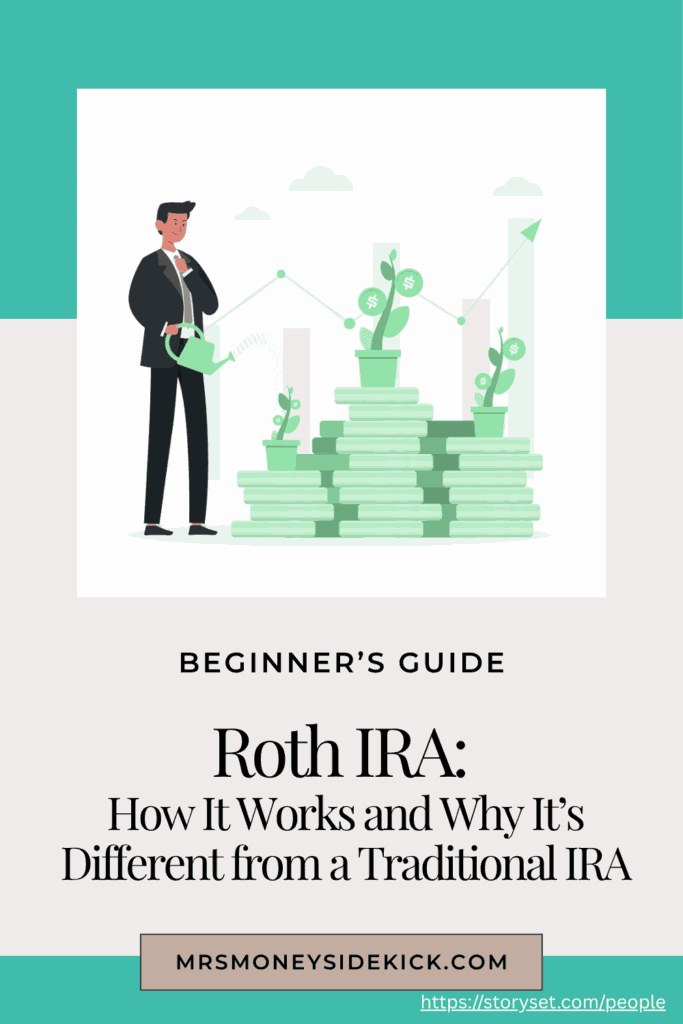Beginner’s Guide to Roth IRA: How It Works and Why It’s Different from a Traditional IRA
If you’re starting your retirement journey, chances are you’ve heard of IRAs, but maybe you’re still wondering what the difference is between a Traditional IRA and a Roth IRA. This beginner’s guide to Roth IRA will break everything down in simple terms: what a Roth IRA is, how it works, how it compares to a Traditional IRA, and why it might be the right choice for your financial future. And don’t worry, we’ll keep the jargon to a minimum and include helpful tips along the way.
What Is a Roth IRA?
Let’s start with the basics. A Roth IRA is an Individual Retirement Account that allows you to invest money for your future after you’ve already paid taxes on it. This is a key difference from a Traditional IRA, where contributions may be tax-deductible upfront.
In a Roth IRA, you don’t get a tax break when you contribute, but your money grows tax-free, and you won’t pay any taxes when you withdraw it in retirement—as long as you follow the rules.
That’s right: no taxes on investment gains, interest, or withdrawals in retirement.
My Story: I Wish I Started a Roth IRA Sooner
For the longest time, I didn’t even know what a Roth IRA was. My dad had encouraged me to contribute to a Traditional IRA from my first year working, and I’m so thankful for that because it got me into the habit of saving for retirement early. But I stuck with just the Traditional IRA for years, without even realizing I had another option. It wasn’t until much later that I learned about the Roth IRA and how powerful its tax-free growth and retirement withdrawals could be.
If I could go back, I would have split my savings or started contributing to a Roth IRA sooner, especially while I was still in a lower tax bracket. That’s when it really pays off.
Roth IRA vs. Traditional IRA: Key Differences
Let’s go over how the Roth IRA compares to the Traditional IRA, so you can see which might work better for you. Since this is a beginner’s guide to Roth IRA, here’s a simple table to make things clear:
| Feature | Roth IRA | Traditional IRA |
| Tax on Contributions | Paid upfront (no deduction) | Possibly tax-deductible |
| Tax on Withdrawals | None (if qualified) | Taxed as regular income |
| Income Limits to Contribute | Yes | No income limit to contribute |
| Required Minimum Distributions (RMDs) | None | Yes, starting at age 73 |
| Best Time to Contribute | When you’re in a lower tax bracket now | When you expect to be in a lower bracket later |
Beginner’s Guide to Roth IRA: How to Qualify
You can only contribute to a Roth IRA if your income falls within certain limits. For 2025, the income limits are:
| Filing Status | Full Contribution If Income Below | Partial Contribution Range | No Contribution Above |
| Single | $146,000 | $150,000 – $165,000 | Over $165,000 |
| Married Filing Jointly | $230,000 | $236,000 – $246,000 | Over $246,000 |
How Much Can You Contribute?
Whether you choose a Roth or a Traditional IRA, the contribution limit is shared.
That means for 2025:
- You can contribute up to $7,000 total if you’re under 50.
- Up to $8,000 if you’re 50 or older.
You can’t contribute the full amount to both a Traditional and Roth IRA in the same year. You must stay within the combined limit, so it’s either/or—or a mix of both adding up to the cap.
Beginner’s guide to Roth IRA tip: If you’re not sure which to pick, you can split your contribution, just make sure the total stays within the annual limit.
Why Choose a Roth IRA?
This beginner’s guide to Roth IRA wouldn’t be complete without explaining why so many people love it:

Pros of a Roth IRA
- Tax-free growth and withdrawals in retirement
- No required minimum distributions (RMDs) ever
- Great if you’re younger or in a lower tax bracket
- You can withdraw your contributions anytime (not the earnings) without penalty
- Flexible for emergencies or even first-time home purchases
Cons of a Roth IRA
- You must wait five years and be age 59½ to withdraw earnings tax-free
- No tax deduction when you contribute
- Income limits may prevent you from contributing directly
- You must wait five years and be age 59½ to withdraw earnings tax-free
Beginner’s Guide to Roth IRA: How to Open One
Opening a Roth IRA is easier than you might think:
- Choose a provider (Fidelity, Vanguard, Schwab, or robo-advisors like Betterment).
- Open the account online (takes about 10–15 minutes).
- Link your bank account to transfer money.
- Choose your investments (index funds, ETFs, target-date funds, etc.).
💡 Pro Tip: If you’re not sure where to invest, start with a target-date retirement fund based on the year you plan to retire. It automatically adjusts your investments over time.
Tips for New Investors
- Start early, even with small amounts, $25/month makes a difference.
- Automate contributions so you don’t forget.
- If you’re unsure about investing, stick with broad index funds or target-date funds.
- Keep track of your contributions, especially if you think you might need to withdraw them later.
This beginner’s guide to Roth IRA is meant to help you take action without feeling overwhelmed. You don’t have to know everything to get started.
Understanding the Roth IRA 5-Year Rule (Don’t Skip This!)
One important thing every beginner should know—especially if you’re following this beginner’s guide to Roth IRA—is the 5-year rule. It’s a rule that affects when you can take money out tax-free, and it confuses a lot of people. So let’s break it down step by step.
What Is the Roth IRA 5-Year Rule?
The Roth IRA 5-year rule says that you must wait at least five years after your first contribution before you can withdraw earnings (the money your investments made) tax-free, even if you’re already 59½ years old. There are actually a few versions of the rule, but the most common applies to retirement withdrawals.
Here’s how it works:
The clock starts on January 1 of the year you make your first Roth IRA contribution, not the exact day you contributed.
You need to meet both:
- Be at least 59½ years old
- Your first contribution must have been made at least 5 tax years ago
If both are true, you can take out both your contributions and earnings tax- and penalty-free.

Example:
Let’s say you open your first Roth IRA and make your first contribution on July 10, 2025. For the 5-year rule, it counts as if you contributed on January 1, 2025.
- That means your 5-year clock ends on January 1, 2030.
- If you’re 59½ or older by then, you can take out everything, contributions and earnings, completely tax-free.
What if You Withdraw Early?
Here’s the good news: You can withdraw your contributions anytime, tax- and penalty-free, because you’ve already paid taxes on them. But withdrawing your earnings before meeting both parts of the rule, age 59½ and 5 years since your first contribution means you might have to pay:
- A 10% early withdrawal penalty
- Income taxes on the earnings
Special Exceptions to the Penalty
Even if you haven’t met the 5-year rule or aren’t 59½ yet, some exceptions may let you avoid the 10% penalty (though income tax may still apply). These include:
- First-time home purchase (up to $10,000)
- Disability
- Certain medical expenses
- Higher education costs
- Birth or adoption of a child (up to $5,000)
💡 Pro-tip: Always talk to a tax professional before withdrawing from a Roth IRA early, just to be safe!
Why the 5-Year Rule Matters
This rule is a big reason why it pays to start a Roth IRA as early as possible, even if you can only contribute a small amount. Starting the 5-year clock now gives your future self more flexibility later. Even if you’re not ready to contribute much, opening the account and putting in just a few dollars this year starts the clock.
Final Thoughts
If you’re just starting your financial journey, a Roth IRA can be one of the smartest long-term moves you make, especially while your income (and tax rate) is lower.
I only wish I had known about it sooner because I spent years contributing only to a Traditional IRA without realizing the Roth option even existed. I missed out on years of tax-free growth and withdrawals. But now I know better and so do you.
The good news is, it’s never too late to get started! Start small, stay consistent, and let time and compound growth do their thing.
On your side,
Mrs. Money Sidekick
P.S. Check out these other money essentials posts for more like this!
Featured Image by People illustrations by Storyset








